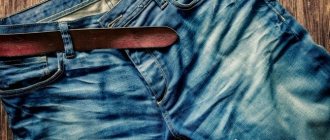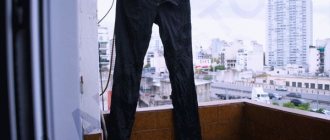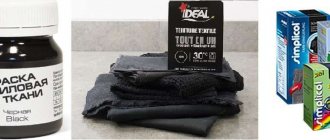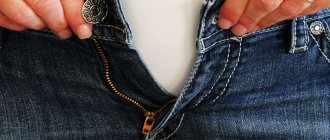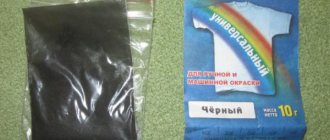How to dye jeans blue
Most often, jeans take on the appearance of an old, worn item when, after numerous washes or due to fading in the sun, they lose color.
How to restore color to jeans? First, let's look at a quick option for giving things a blue or blue tone using blue.
To tidy up and update blue or blue jeans, they have been using bluing since Soviet times. What is this paint? Blue is a solution of an organic dye - methylene blue. Pigment is used to give a bluish tint to natural fabrics.
How to dye jeans at home:
How to dye jeans blue? Follow the instructions:
- Pour the contents of the blue package into an enamel or plastic bowl. Add slightly warm water (not higher than 30 °C). Adjust the amount of water based on what color you need.
- To make the shade more durable, add 3-4 tbsp to the solution. l. salt. Stir.
- Place the denim item in the blue liquid.
- Leave for 3-4 hours. Remember to turn the jeans over periodically to ensure an even color.
- Rinse the item in a weak vinegar solution (50 ml of vinegar per 5 liters of water).
Potassium permanganate, or potassium permanganate, can give jeans a bluish or purple tint. To tint something, follow the same steps as when painting it blue.
Be prepared for the fact that the color after bluing or potassium permanganate will be washed out with each subsequent wash.
How to use blue for linen?
Household blue is considered a mixture of dye and starch, sold in powder or liquid form. The substance is usually used as a bed linen freshener. Linen bluing allows you to make linen and cotton shirts white. It is also used for tinting materials. More details about this tool are described in the article.
Blue for linen is divided into 2 types: with soluble and insoluble dye. The second option is considered cheap; it is used only when refreshing products. Soluble - for dyeing clothes.
Compound
What is the composition of blue for linen? It is a sodium aluminosilicate containing sulfur and sodium sulfate. In the USSR, grade 1 and grade 2 products were sold, which differed in intensity and shade. The blue should dissolve easily in water. Because of its lightness, it does not stay at the bottom for long. The composition of the Soviet product excluded the presence of organic dyes, Prussian blue and soot.
How to dye jeans black
Before you dye your jeans black, you need jeans dye. The dye "Tekhnokhim" has proven itself well, the composition is Jeans, it is sold in hypermarkets or in handicraft stores.
Jeans dye is a blue-gray powder. Before dyeing black or blue jeans, put on rubber gloves, pour dye powder, 200 grams of salt, and jeans soaked in water into the drum of the washing machine.
Select the cotton program 60 or 95 degrees. The longer the washing time, the more saturated the color will be. We are waiting for the process to finish. Next, after finishing the washing cycle, you need to fix the black color. To fix the color, pour 5 tablespoons of vinegar into the dish of the washing machine and turn on the “rinse” mode. Do not turn on the spin mode! Otherwise, the dyed jeans will end up with streaks.
What will we paint with?
So, we’re thinking: how to dye jeans?
If you decide to make your favorite but old jeans new, then this can be done in several ways, and many different dyes are sold for these purposes. When buying bags of paint, look at the instructions on how this paint can be used and whether this method will be available to you.
Don't try to come up with something of your own because you might ruin your jeans. Be sure to wash and dry your jeans before dyeing, and then you can experiment.
How and with what to dye black jeans
When dyeing black fabric, you have to restore the original shade, so only black dye is needed.
Powder dyes for jeans
A universal powder dye for fabric is perfect for jeans.
It is used economically, acts effectively, and does not spoil the structure of the fabric. Using it according to the instructions, achieving the desired result will not be difficult.
Fabric paint
Hardware stores sell fabric dyes. They have a powder structure and are used for painting in the washing machine.
- The powder is mixed with water in the proportion prescribed by the manufacturer.
- The jeans are turning inside out.
- The machine sets the temperature allowed for jeans.
- If the instructions for the paint do not indicate that it requires dilution, then it is poured into the drum onto the jeans that were previously placed there.
- Fabric softener is not added as it may alter the dyeing result.
- The machine is set to a mode for jeans; if it is not there, then a mode is selected, for example, for cotton or linen, at which the water temperature will be 80-90 °C.
- After washing is completed, the jeans are rinsed in cool water with a vinegar solution added to fix the color.
- After rinsing, the jeans are washed again on a short cycle with powder.
- Dry away from heating objects.
Hair dye
It is better to choose a natural dye without ammonia. On average, one pair of jeans takes two packs. The paint is diluted using the usual method according to the manufacturer's recommendations. Clothes are placed in a deep basin and completely filled with warm water in which the prepared paint is diluted. Jeans remain in the dyed mixture for 1.5-2 hours.
After soaking, rinse first in water at room temperature, and then in cold water with vinegar and salt. Then they are washed by machine with the addition of powder and dried in natural conditions.
Aerosol and acrylic paints
They help not to re-dye jeans, but to decorate them. Aerosol paints are simply sprayed onto laid out clothes, and an arbitrary image is drawn with acrylics. Paint with a brush or the edge of a washcloth. The image is unique, but uneven. Additionally, you can use a stencil. To fix the acrylic, the jeans are placed between layers of white paper and ironed.
Ink from felt-tip pens
The rods are removed from several black felt-tip pens and lowered into slightly cold water. When the water turns black, the jeans are immersed in it. After an hour, it is removed from the ink solution, washed with powder and dried.
Useful tips
If you are going to paint any item of your wardrobe for the first time, then consider the following nuances:
- Only natural cotton, wool or linen are dyed evenly. When dyeing other fabrics, there is a possibility that the clothes will be dyed in pieces.
Important! If you are not sure about the composition of the fabric and do not want to take risks, try test dyeing - dye a small piece of fabric specifically from your product.
- You only need to paint a thoroughly washed product without stains, otherwise the paint will lie unevenly.
- Clothes are placed in the machine wet - this way they are better dyed.
- If you want to dye an item a darker color to hide a stain, it will still be visible because stained clothing is not dyed evenly.
Important! Rust stains are practically impossible to paint; it is easier to decorate them in some other way, for example, by sewing on an applique.
- It is unlikely that you can get a black one from a white item right away. You will most likely have to do several paint jobs before you get the shade you want.
- A freshly dyed item will fade, so it is not recommended to wash it with other items for up to five washes.
- It is not recommended to paint synthetics, since they do not stain evenly, no matter what paint manufacturers write. But if you really want to experiment, then do a test dyeing on a piece of material, and only if the result is positive, paint the entire thing.
- The color indicated on the package is obtained if you dye a white item. But if your product is a different shade, then at the end you risk getting a completely unexpected color, albeit in a similar color scheme.
- As a rule, the threads with which the product is sewn are not dyed, so think in advance about how they will be combined with the new color of the clothing.
- If you add conditioner while painting, the paint will not apply evenly and your clothes will become stained.
- Jeans are dyed on both sides.
Important! If you are going to update the design of your item in this way, be very careful about choosing the right product. Find out all about the best fabric paints.
Application of whiteness
For a long time in the post-Soviet space, denim jeans have remained trendy. Every self-respecting fashionista knew by heart the secrets of creating a fashionable new thing from ordinary trousers. This is a simple matter, since the usual “Whiteness” will help you.
- Dilute a glass of “Whiteness” in a bucket of water.
- Twist the item well into a sausage and secure it in several places with rubber bands.
- Immerse them in a container with the solution and begin to gradually heat the basin on the stove. In this situation, you will need at least 15 minutes for the procedure. Be careful not to let the jeans float to the surface.
In this way, you can dye black or blue jeans so that large unusual patterns are formed on the surface.
Two more simple ways to resuscitate jeans
In the distant, distant times of the USSR, there were no special dyes to restore the color of jeans, but there were jeans themselves, and, just like today, they quickly wore out. It was then that simple but effective ways to dye jeans were invented.
Making "varenki"
In the 80s of the 20th century, the so-called “varenki” were especially popular. They were terribly expensive, and it was almost impossible to buy them. But folk craftsmen found a way out - how to make super fashionable dumplings in a bucket in the kitchen of a Soviet apartment. Everything turns out to be very simple, and you can repeat this experiment with old jeans. Manufacturing stages:
- You twist your jeans in different directions as tightly as possible, then we twist them into one lump and tie them with ropes.
- Pour water into a bucket, add 200 grams of white, and drop the rolled jeans into it.
- Bring to a boil and cook for 15 minutes.
- We try to constantly keep the jeans under water.
- We take it out, untie it, rinse it, dry it.
Blue jeans
How to turn jeans blue? In some cases, when jeans are not yet completely dead, blueing can be used to give them a fresher look. How it's done:
- Pour warm water into a basin or bucket and add a little blue; you need to select the amount of powder yourself.
- Soak the jeans in the solution for 2 hours.
- Remove, squeeze, and rinse in cold water and vinegar.
It’s simple, but this method doesn’t last long; usually, after the third wash, the jeans return to their previous state.
Features of denim dyeing
The most common jeans in stores are all shades of blue, light blue and gray. Grays and blacks fade the most over time. Dark blue colors are long lasting.
It should be borne in mind that even after several dyeing procedures, denim is unlikely to become perfectly black, as in the store. Even with professional products you will get a dark gray color.
Preparing tissue for the procedure
To ensure that the paint goes on as evenly as possible, you need to prepare the denim for dyeing:
- Wash the product thoroughly. Set the water temperature to 40°C - this is the optimal value for denim. Wash as usual - with powder and conditioner. After washing, do not dry the jeans - dyeing is done on damp fabric. For light blue and light blue jeans, this step is sufficient. Further actions are carried out on products of bright or dark colors: red, burgundy, purple, dark blue and the like.
Washing is necessary to remove substances from the fabric that may interfere with the coloring or make it uneven. - Fill a large saucepan with water. The size of the pan should be large enough to wash jeans in it. Add bleach to water. Ordinary chlorine may also work, but it is better to use more gentle products, for example, Belize. It is added to water in a ratio of 1:10. Washing should be done in a well-ventilated area, as chlorine vapors are hazardous to health.
White is a good way to bleach jeans. - Place a saucepan of water over high heat.
The size of the pan should allow the product to be completely soaked in it. - When the water is ready to boil, reduce the heat to low and place the jeans in the pan. While stirring the product with a long wooden spoon or spatula, soak it in hot water until it lightens by 2-3 shades. Some jeans may change color to beige or yellowish - this is normal. Discoloration will take 30 to 60 minutes.
A wooden spoon with a long handle is convenient for stirring jeans in a large saucepan - the wood does not heat up from the steam - Turn off the heat and drain the bleach solution from the pan. Rinse your jeans thoroughly.
To remove bleach from jeans, rinse them in running water. - Wash the jeans again in the washing machine using detergent. This will remove any remaining bleach that could interfere with the paint job or damage the fabric. Do not dry the product before painting.
Preparation
Painting can be easily done at home, using improvised materials or special products, which are widely produced by the industry. In order for the paint to lay evenly and adhere reliably, you need to properly prepare the jeans and the dye itself.
Wash
Jeans are washed so that dirt does not interfere with the absorption of dye. Washable by machine or by hand. For the machine, an additional rinse mode is set; when washing by hand, rinse in several waters. Do not use conditioners or other softening compounds; rinse fabric detergents thoroughly.
Removing stains
Before washing, jeans are inspected and stains are removed. The presence of fat or other contamination on the fabric will negatively affect the dyeing of this area of the jeans.
Dirt is removed using stain removers for colored fabrics, after which the item is washed.
Drying
After washing, the jeans are dried.
Smooth out all folds and creases
To ensure that the paint lays evenly and penetrates deeply, the jeans are ironed, carefully smoothing the fabric at the waistband, fasteners, and near the seams. On creases, the dye may be thicker or weaker, ruining the product with stains.
Bleaching
The most difficult type of painting is repainting it in a different color. First you have to remove the original dye from the denim. To do this, jeans are bleached using bleach or another bleach.
Choosing a coloring agent
Dyes are selected according to the type of fabric. For cotton, dye for natural dense materials is suitable. Before purchasing, study the instructions on the drug and the label sewn into the jeans.
How to prepare dye correctly
Factory dyes are produced in the form of powders, liquids, and tablets. Before use, you need to read the instructions, select the required volume of water, and understand how much substance is needed for coloring. The paint is diluted in a small volume of water, stirred thoroughly until completely dissolved. Strain through a thick cloth so that undissolved grains do not spoil the item. Only after this is mixed with the main volume of water.
Important: if possible, labels, tags, and decorative details are evaporated from jeans before painting. They will color unexpectedly and ruin the item. The artisanal coloring will be noticeable on them.
Natural dyes
What else can you tint your jeans with? To give a green tint, a solution of pharmaceutical green is suitable. Light-colored products are easily colored with herbal infusions, berry and fruit juices. Berries give the most durable coloring. Remember how difficult it can be to remove a random drop of juice from clothes. The downside of this method is that you will need a lot of berries to squeeze the juice.
Blackberries, blueberries, and cauliflower give fabrics a blue tint. Brown color - tea leaves, oak bark. Yellow - turmeric, dried calendula flowers. Pink - cherry or raspberry juice.
General rules for coloring with infusions and juices:
- A decoction or infusion is prepared from herbs, and juice is squeezed from berries.
- The intensity of the color depends on the amount of water added.
- The fabric is soaked for at least 4-5 hours.
- To ensure uniform coloring, you need to stir the product.
- Rinse in a weak vinegar solution.
Where can you dye clothes?
You can restore faded or faded dye on textiles at home or at a dry cleaner. Coloring things will help restore the previous shade or create a new one. If your white jeans have faded to a yellowish or gray color, they can be dyed or bleached.
You can dye textiles at home by hand or in a washing machine. Both of these methods are effective and extremely simple. Using the recommendations, you will cope with the task without much effort.
Manual painting method
To work with textiles you will need:
- Dye;
- Household scales;
- Salt;
- Vinegar in an amount of 30 ml;
- Large metal container.
- The dyeing method depends on the dye that will be used. Using a scale, you need to determine the weight of the clothing in order to accurately calculate the proportion of the dye. The intensity of coloring and color fastness will depend on this.
- Vinegar and salt are used to fix the paint. These substances are dissolved in water and textiles are rinsed in them. The last rinse is carried out in cool water without additives.
Changing the color of clothes in the washing machine
- Many people are familiar with the situation when one colored sock can turn a dozen white things into a different color. An absurd problem was inspired by the method of household dyeing of clothes.
- The whole process can be divided into several stages:
- Prepare the product for painting. This could be pants or a jacket. It is important to pre-wash, remove stains if possible and remove decorative elements.
- Measure the weight of the clothes.
- Prepare the dye according to the instructions.
- Strain the prepared solution through cheesecloth or a fine sieve and pour into the drum or compartment for washing powder.
- Place clothes in the washing machine compartment. It is better to load items immediately after pre-washing. Damp fabric is easier to dye.
- Set the boiling program to 95 degrees.
- Set the timer for at least 30 minutes.
- At the end of the wash cycle, add salt to the drum and rinse. The amount of salt should correspond to the proportion: 1 cup per 1 kg of fabric.
- You can repeat the vinegar rinse and do a short wash without additives to lock in the dye and wash out any remaining dye that didn't take.
- Remaining pigment can be removed from the drum by dry washing with liquid bleach. The rubber seal should be wiped with a clean cloth.
How to Work With Black Denim Pants
The most reliable way for those who are going to dye trousers is to purchase specialized fabric preparations. Such means can give the material black, blue, cyan tones. If you do not have the opportunity to purchase the drug, you can dye your jeans black with hair dye at home. The method is interesting, but it is better to resort to its use in extreme cases. The procedure flow looks like this:
- Buy some paint. When choosing, pay attention to its shade. Try not to make mistakes, otherwise you will most likely not be able to get the desired tone. Just in case, if your panties are too big, buy a couple of packs.
- Dilute the drug in water. Determine the amount of water “by eye” so that you can subsequently completely immerse your pants in it. Leave the item in the solution for an hour and a half.
- As soon as the deadline expires, rinse your pants. First, immerse in clean water, then add soda and salt.
- Dry the new item and evaluate the result.
Important! You can dye your jeans with hair dye, but remember that the result can be the most unexpected.
Blue for jeans
The simple and affordable composition is ideal for restoring the color of classic denim items. The drug is available for purchase in hardware stores. Please read the instructions carefully before use.
Please note that the substance is suitable for tinting blue items. It will not be possible to completely change the shade with this help. The durability of the bluing is not high, so after a while you will have to repeat the procedure.
Another point that cannot be neglected is that during the washing process after dyeing, the pigments from the fabric will be washed out, so it is better to wash the item separately from others or with clothes of the same color.
Steps
Part 1 of 3:
Preparing jeans for dyeing
- 1
Wash your jeans.
To ensure that there are no substances left on the jeans that you are going to dye that could interfere with the dyeing process, they must be washed first. Place them in the washing machine and wash as usual, following the care instructions on the jeans' sewn-in label. X Source of information
- There is no need to dry your jeans after washing. They must be wet before bleaching or dyeing.
If you have blue or light-colored jeans that you don't intend to bleach, the only thing you need to do before dying is to wash them. In this case, you can skip the rest of the steps in this part of the article.
Part 2 of 3:
Preparing the Paint
- Part 3 of 3:
Dyeing jeans
1
Press out any wrinkles on your jeans.
Jeans should be wet after washing. Before putting the jeans into the pan, squeeze them out again to make sure there is no excess moisture left in them. Then straighten the jeans so that when you dip them into the dye, there are as many wrinkles as possible. X Source of information
- 2
Place the jeans in the pan and stir them in the solution for a while.
Dip the straightened jeans into the paint pot. Using a large, long spoon, stir them for 30 minutes or until they are as black as you want them. X Source of information
- As you stir the jeans, move them back and forth, up and down. It is necessary to ensure that the dye evenly saturates the denim fabric.
Be careful not to twist or wrinkle the jeans due to stirring. This may result in uneven coloring.
- 3
Remove jeans from pan and rinse thoroughly until clean.
When you are happy with the results of dyeing your jeans black, remove the pan from the stove and transfer the jeans to the sink. Rinse them in the sink with warm water. Gradually start making the water colder until all the excess paint is washed away and the water runs completely clear. X Source of information
Some dyes may come with a dye fixative for cotton fabrics to prevent fading. It can be used to treat jeans immediately after dyeing in accordance with the manufacturer's instructions provided.
- 4
Hand wash your jeans.
After dyeing your jeans, hand wash them directly in the sink. Use warm water and liquid detergent for hand washing. Then rinse your jeans with cool water. X Source of information
If you want, you can wash your jeans in the washing machine along with an old towel. The towel will absorb any excess paint that comes off the jeans.
- The first few times you machine wash and dry your jeans, be sure to add an old towel or other dark item to them in case the dye continues to wash out. To prevent paint from fading, use cold or warm water and a gentle liquid detergent.
- It is obvious that textile paint leaves behind stains on fabric surfaces. For work, wear old clothes that you don’t mind getting dirty during the process of dyeing jeans, and also protect your hands with rubber gloves. Clear your workspace of textile items, including towels, rugs and curtains.
- Be careful when wearing freshly dyed jeans. They can leave marks on light-colored upholstered furniture, even after the paint has set. Be sure to rinse them thoroughly after dyeing.
- Even after several dyeing procedures, the jeans will not become as deep black as store-bought black jeans. Be realistic in your expectations.
- Washing machine
- Machine washable detergent
- Large stainless steel saucepan
- Big long spoon
- Water
- Latex gloves
- Bleaching agent
- Jeans
- Disposable polyethylene tablecloths
- Liquid or powder black paint for textiles
- Salt
- A piece of cloth or paper to test the dye
- Liquid detergent for hand washing
Extreme and experimental dyes for denim
Experimenters who are not tempted by proven and modern dyeing methods can turn to folk ingenuity. It is unlikely that high-quality uniform coloring can be achieved with the following options, but if someone is not afraid of unexpected results, why not try? After all, if methods exist, then someone needs it.
- Marker ink. To get paint, you need to dip the rods of a dozen or two felt-tip pens into water and leave until they turn completely white. Dip jeans into the resulting liquid and leave for a couple of hours. It is worth considering that the fabric should be much lighter than the felt-tip pens used.
- Natural dyes are also great for denim. Every food product contains pigment in greater or lesser quantities. If you choose bright vegetables, fruits, berries, herbs, seasonings, you can get an interesting result. Grind the selected ingredient and add water 1:2. Boil and let it brew for longer, the richer the desired color. Strain. Dilute 4 parts vinegar with 1 part dye, add ½ part salt. Boil the jeans in the resulting solution for an hour.
- Hair dye. For one pair of pants, take 2 packs of ammonia-free paint, dilute with water (it should be enough to completely cover the jeans, but no more). Soak the jeans for a couple of hours.
- Henna and coffee will give your jeans a brown color. Mix a pack of henna with 2 tbsp. ground coffee. Use in the same way as natural paints.
Waxing
After waxing, the denim material becomes impervious to external factors, and the paint applied to it will be more resistant to washing.
Wax impregnation is purchased or prepared from beeswax, linseed and turpentine oil. First, wash to remove dirt, and after drying, you can start waxing:
- wax is heated in a water bath;
- the wax mass is evenly distributed in a thin layer over the jeans with a soft washcloth;
- during application, the jeans are dried with a home hairdryer;
- After application, the item is left to dry completely in a dry room.
Aerosol painting
It is unlikely that you will be able to achieve uniform painting with spray paint, but you can show your imagination and create fancy patterns. When using an aerosol, it is better not to disdain the stencil, otherwise you may catch excess fabric.
Not only a dye specifically for denim, but any available paint in a can will work well and last a long time.
How to use aerosol sprays?
There is no need to completely paint over the fabric on the trousers with spray paint - it is better to use it to create color accents by dividing the entire surface of the product into sectors or highlighting individual areas using a stencil.
Technology:
- Thinking through the design.
- Prepare the trousers (get rid of stains, wash, dry thoroughly and iron).
- For sectorial application of paint or when using a stencil, cover untreated areas with paper.
- The painted elements are allowed to dry thoroughly, following the product manufacturer's recommendations.
Potassium permangantsovka
“Boiled jeans”, which came from the 80s, can be created using potassium permanganate. The difference from the traditional method is the complete absence of heat treatment.
- First, prepare a solution: 135 ml of vinegar 9% with 80 g of potassium permanganate, with the addition of 30 ml of hydrogen peroxide 3%.
- Keeping a 2:1 ratio, fill a reservoir with water and pour in the prepared mixture.
- The pants are twisted into a rope and secured with ropes or elastic bands.
- The prepared product, which must be completely immersed under water, is placed in the solution for 20 minutes.
- After the required period has passed, the jeans are rinsed by hand, followed by machine washing.
Zelenka
Peculiarities. If you want to dye your jeans green, use regular green dye. By the way, if you combine the drug with strong tea leaves, the product will acquire a beautiful emerald hue. And if you want to get a blue-black tone, add the same amount of fucorcin to the brilliant green.
- Pour brilliant green into warm water, following the proportion: 5 liters of water - 10 ml of the drug.
- Dip the product into the dye solution.
- Let the jeans sit for 20 minutes to two hours, depending on the desired shade.
- Be sure to rinse the product in cool water.
- Then dip the item in a fixing vinegar solution (100 ml of table vinegar per 3 liters of water).
- Wash with powder as usual.
Hair dye
To understand how acceptable this method is for dyeing coarse fabrics, it is advisable to carry out the first attempt on “denim”, which has already seen its fair share of wear and tear and can then be thrown into the trash without much mental anguish.
Steps in the process of applying hair dye:
- The product is washed and rinsed.
- Four portions of dye, previously thoroughly diluted to a liquid state, are dissolved in 7-8 liters of moderately hot water.
- Dip the product into the solution and leave it to soak for an hour and a half to two hours. Periodically squash the jeans in the water and turn them over.
- At the end of the allotted time, the “denim” is soaked in an acidic medium with the addition of salt - a spoonful of each component (the second is 6-9% vinegar) per liter of water.
- After all the manipulations, the item is washed in a delicate mode using a small amount of gel or powder.
Tea, coffee, tobacco
Vegetable dyes paint over faded or faded areas. This coloring is enough for 2-3 washes, then the shade fades.
- Very strong coffee is brewed with a small addition of water. Black tea or tobacco can be used. The finished brew is cooled and filtered. The color should be inky black.
- A large basin is filled with water to a third of its volume and placed on the stove.
- After boiling, the prepared tea leaves are added to the liquid in a similar quantity.
- The composition is brought to a boil and removed from the stove.
- The denim material is immersed in a bowl of infusion solution using a long spoon or boiling tongs.
- Jeans can remain in the basin for 2-3 hours or all night.
- Afterwards, the clothes are thoroughly rinsed with running water.
Vegetables, berries, herbs
It is difficult to qualitatively change the color of jeans with fruit and vegetable dyes. At best, they will acquire a new pastel shade, but they cannot be made bright.
Process steps:
- The product is crushed and boiled in water - ratio 1 to 2.
- “Compote” is kept for 10-12 hours and filtered.
- Jeans are prepared for dyeing by boiling for an hour in a fixing composition: sour if the compote is vegetable, salt if it is fruit. For the solution, use the formula: 1 part vinegar to 4 parts water or 50 g of salt per liter of water.
- After rinsing, the jeans are transferred to a vat with a dye composition and kept until the fabric acquires the desired shade.
- After the final rinse, dry the item in the shade, allowing the water to drain on its own.
Natural foods and herbs
To dye jeans, you can resort to natural ingredients. They are easy to prepare paint to achieve a wide variety of colors. To select the correct component, use the table.
Table - Products that serve as the basis for making paint
| Hue | Ingredients to obtain the desired color | Red and pink color | - Beet; - elderberries; - blueberry; - oregano | Beige, cream | — Strong instant coffee; - rich tea brew | Orange | — Sea buckthorn (berries) | Green | — Stem of marsh horsetail; - juniper berries | Brown color | — Dry buckthorn bark; - horse sorrel roots: - saturated solution of onion peels; - cinnamon | Mustard, honey, yellow | - Onion peel; - orange and lemon zest; - wormwood; - turmeric; - birch leaves | Violet | - Blueberry; - red cabbage | Light blue, blue color | - Blackberry; - meadow sage herb |
Description of the procedure
Peculiarities. If you are planning to carry out a design game with color spots, resort to using several solutions. To partially dye jeans by hand, you can apply paint to certain areas or dip the product in pieces in different solutions.
- Cut or chop the selected component and add water in a 1:2 ratio.
- Place the pan on the fire and bring to a boil.
- Remove from heat and let the solution sit for two hours. If you want to get a more saturated color, then leave the mixture for eight to ten hours (overnight).
- Strain the resulting solution thoroughly.
- If you prepared paint from vegetables, then prepare a fixing solution based on vinegar, using the ratio: one part vinegar to four parts water.
- To fix the berry paint, you will need a saline solution: half a glass of salt for eight glasses of water.
- Initially, dip the jeans in the fixing solution and boil them over low heat for one hour.
- Then rinse the product in cold water and dip it in the dye solution.
- Move the jeans periodically to ensure they are dyed evenly.
- The longer you keep the item in the paint, the richer the new color will become.
- After the procedure, rinse your jeans and let them dry on their own.
The question of whether you can dye your jeans yourself is no longer worth it. But keep in mind one more recommendation. All surfaces that come into contact with the paint will also acquire a permanent tint. Therefore, if you do not want to walk around with green or blue hands, work with gloves.
Coloring methods
There are several ways you can dye denim at home. The choice of method depends on how much effort, money and time you are willing to spend on changing the color.
Manual
Hand-dying faded jeans is not as difficult as it might seem at first. For the procedure you will need:
- dye;
- large container that can accommodate jeans;
- a small bowl/bottle to dilute the dye;
- salt;
- soda;
- stirring spatula;
- water;
- gloves.
There are hot and cold dyeing methods. The hot method is used for most professional dyes. It involves boiling the item in paint; therefore, it is only suitable for dense natural fabrics.
Procedure:
- Pour water into a large enamel-lined saucepan so that it fills ⅔ of the volume.
- Heat it over high heat until almost boiling.
- Add soda and salt in equal quantities (5-7 tbsp), dye in the proportion indicated in the instructions.
- Mix the liquid thoroughly and wait until the soda and salt dissolve.
- Place jeans in the solution and cover the pan with a lid.
- Stirring occasionally, cook the product in the dye for about an hour - the more time passes, the richer the color will be.
- After painting, rinse the jeans well several times.
The processing time for jeans also differs:
- it takes half an hour to dye light-colored clothes;
- dark products are boiled for 40-45 minutes;
- black things need to be cooked for about an hour.
To fix a fresh shade, you need:
- Make a solution: 2 tbsp. l. 9% vinegar in 1 liter of water.
- Soak jeans in it for 15-20 minutes.
- Rinse them in the same solution.
The cold method is very simple and convenient, because the smell and dye vapors do not spread throughout the apartment. Typically, this method is used when it is not possible to paint the item with special paint or in a washing machine.
You can change the color of a product using the cold method using such means as:
- blue;
- industrial dye;
- hair dye.
Procedure:
- Prepare a large container.
- Pour water at room temperature into it.
- Add the desired dye according to the instructions.
- To stir thoroughly.
- Immerse the product in the liquid.
- Soak it for 1-2 hours.
- Treat jeans with a fixing compound.
- Rinse them.
Attention! It is necessary to maintain proportions - this will help to dye the denim evenly and neatly. When dyeing white items, the volume of water should be 30-40 times greater than the weight of the jeans; if you need to paint dark products - 20 times.
The main advantage of the manual method is that you can completely control the process. This is especially important if you want not only to refresh the color, but to paint your clothes creatively, with a designer approach. Various twists and creases of the fabric can create beautiful patterns and patterns, which allows you to make a unique item.
In the washing machine
You can also dye denim in a washing machine. However, it will not be possible to control the painting process or make interesting and unusual stains - after immersing the clothes in the drum, nothing depends on the person.
You can dye denim trousers in the washing machine in the following way:
- Prepare the dye - it is better to dilute the dry powder with hot water in advance, rather than pour it straight into the machine. This will help achieve an even color.
- Strain the solution through a gauze cloth to remove undissolved lumps of dye - they cause dark spots.
- Pour the product into the drum of the washing machine (you can also use the powder compartment, but in this case the result will be slightly worse).
- Turn the jeans inside out and place them in the washing machine.
- Set the maximum temperature to 90-95°C. Usually the acceptable value on the denim label is 40°C, but this will not be enough to change the color.
- The duration of painting should be at least 1.5 hours.
- After the end of the cycle, soak the jeans for 25 minutes in a solution of 2 tbsp. l. 9% vinegar in 1 liter of water.
- Wash in the washing machine using the usual settings (temperature – 40°C). This procedure will help remove excess paint from equipment and clothing.
Attention! Even after the second wash, colored water may remain in the washing machine. To prevent items from being damaged during subsequent washes, you need to run the cycle again in idle mode. You can add a solution of citric acid - it will not only remove the dye, but also clean the washing machine from scale.
Dry cleaning
If the item you need to dye is expensive or you are not sure that you can make the color of your jeans even, dry cleaning will come to the rescue.
There are several reasons why you should entrust coloring to professionals:
- uniform color, exact match to the shade from the palette;
- professional dyes, large selection of colors;
- possibility of partial coloring;
- saving time and effort;
- no contact with caustic chemicals, which is important for allergy sufferers.
Product care. How to keep color longer
As soon as the jeans are dyed at home, you need to think about color preservation. To do this, you need to follow several principles:
- Do not wash the product in hot water.
- Using laundry soap for washing.
- Select a delicate washing mode in an automatic machine or gentle hand washing.
- Prohibition on the use of fabric softener.
- Wash separately from other items.
Dyeing jeans is not the most difficult process that anyone can do at home. The main thing is to carefully select the dye, follow the instructions and properly care for your pants after dyeing.
Common Mistakes
An unsuccessful result results from the following errors:
- the color is uneven, stains on things - the powder dye is poorly diluted;
- the paint is washed off quickly - the wrong dyeing time and temperature were chosen;
- stains that have not been removed from the item may turn a different color and become more noticeable;
- an expired drug or a dye that does not match the type of fabric will lead to unpredictable results.
The paint is not mixed with washing powder, fabric softeners, and is injected directly into the drum.

